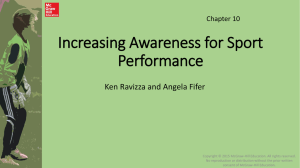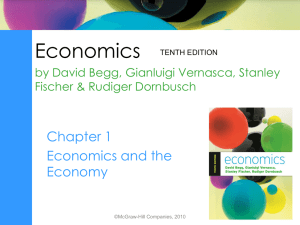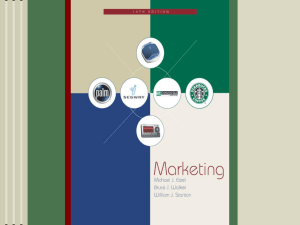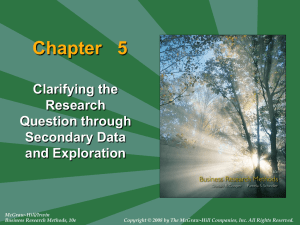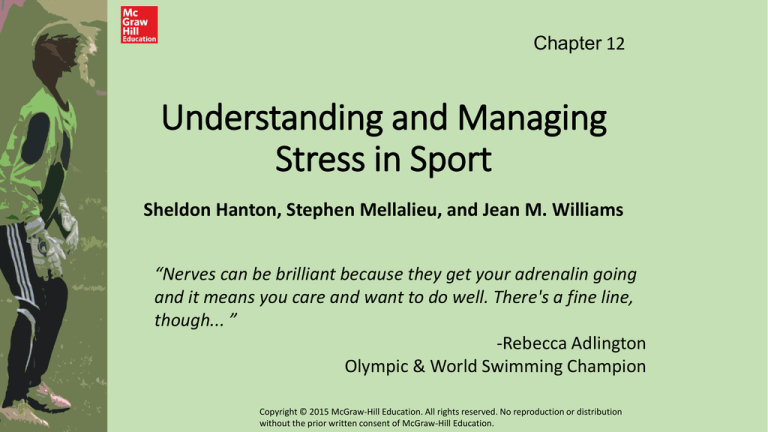
Chapter 12
Understanding and Managing
Stress in Sport
Sheldon Hanton, Stephen Mellalieu, and Jean M. Williams
“Nerves can be brilliant because they get your adrenalin going
and it means you care and want to do well. There's a fine line,
though... ”
-Rebecca Adlington
Olympic & World Swimming Champion
Copyright © 2015 McGraw-Hill Education. All rights reserved. No reproduction or distribution
without the prior written consent of McGraw-Hill Education.
Stress
• Integral to any athlete’s preparation is some form of
stress management
• Goals = optimal mental and physical state ready to
perform AND strategies to cope with any challenges
that may present themselves during competition
Copyright © 2015 McGraw-Hill Education. All rights reserved. No reproduction or distribution
without the prior written consent of McGraw-Hill Education.
Cognitive-Behavioral Stress
Management
• Change cognitions and thought patterns to influence
behavior
• Cognitive motivational relational theory (CMRT)
• The experience of stress as an ongoing evaluation of the
demands an athlete faces (internal and environment)
• TRANSACTION: relationship between the demands of the
environment an individual faces and the resources they
possess to deal with it
• Threat = when athletes perceive resources are too
insufficient to meet the demands of the situation
• Threat elevates with the individual’s perception
Copyright © 2015 McGraw-Hill Education. All rights reserved. No reproduction or distribution
without the prior written consent of McGraw-Hill Education.
Causes of Stress
1. Competitive stressors
•
Examples: the level of physical preparation attained;
the standard of the opponent; the internal and
external pressures and expectations to perform
2. Organization stressors
•
Examples: the performer’s role in the sport
organization; sport relationships and interpersonal
demands
3. Personal stressors
•
Examples: lifestyle issues, financial demands, the
relationships with family or significant others
Copyright © 2015 McGraw-Hill Education. All rights reserved. No reproduction or distribution
without the prior written consent of McGraw-Hill Education.
Responses to Stress
• Arousal
• Generalized physiological and psychological activation of
the person
• Activation
• the overall physical and mental state that is required by an
athlete to be ready to perform a respective task or activity
Deep
sleep
Extreme
excitement
Copyright © 2015 McGraw-Hill Education. All rights reserved. No reproduction or distribution
without the prior written consent of McGraw-Hill Education.
Responses to Stress (cont.)
• Competitive anxiety
• Situation-specific negative emotional response to one’s
view of competitive stressors and competition as threats
COGNITIVE ANXIETY
RESPONSES
thoughts experienced in
stressful situations
•Worries
•Negative expectations
•Performance
apprehensions
Copyright © 2015 McGraw-Hill Education. All rights reserved. No reproduction or distribution
without the prior written consent of McGraw-Hill Education.
SOMATIC ANXIETY
RESPONSES
perceptions of arousal in
stressful environments
•Muscular tension
•Butterflies
•Increased heart rate
•Dry mouth
•Perspiration
Responses to Stress (cont.)
• Competitive anxiety
• An athlete might experience anxiety as
positive OR negative
• The key message for sport
psychologists is to understand that
how athletes evaluate and appraise
the symptoms they experience will
influence subsequent efforts and
strategies toward maintaining optimal
performance states
• Self-regulatory skills
Copyright © 2015 McGraw-Hill Education. All rights reserved. No reproduction or distribution
without the prior written consent of McGraw-Hill Education.
Responses to Stress (cont.)
• Measurement of Stress-Related Symptoms
• Assess the experiences of the stress process and its
consequences with questionnaires
• Trait anxiety - general predisposition to respond across many
situations with high levels of anxiety because of typically
appraising situations as threatening
• State anxiety - varies from moment-to-moment and fluctuates
proportionately to the perceived threat of a situation
•
trait anxiety,
state anxiety
Copyright © 2015 McGraw-Hill Education. All rights reserved. No reproduction or distribution
without the prior written consent of McGraw-Hill Education.
Responses to Stress (cont.)
• Beware of questionnaires
• Not all individuals are willing to give
open and honest responses
• Not necessarily objective
• Sport psychologists should seek a
comprehensive range of assessment
strategies to fully diagnose stress
experiences
• Also, make sure to explain the
relationships between stress and
performance!
Copyright © 2015 McGraw-Hill Education. All rights reserved. No reproduction or distribution
without the prior written consent of McGraw-Hill Education.
Early Arousal-Based Approaches
• Drive theory
• Increases in drive or arousal are associated with linear increases in
performance providing that the task is well learned
• Debunked – nothing supports it
Copyright © 2015 McGraw-Hill Education. All rights reserved. No reproduction or distribution
without the prior written consent of McGraw-Hill Education.
Early Arousal-Based Approaches (cont.)
• The inverted-U hypothesis
Copyright © 2015 McGraw-Hill Education. All rights reserved. No reproduction or distribution
without the prior written consent of McGraw-Hill Education.
Early Arousal-Based Approaches (cont.)
• The inverted-U hypothesis with individual differences
Copyright © 2015 McGraw-Hill Education. All rights reserved. No reproduction or distribution
without the prior written consent of McGraw-Hill Education.
Early Arousal-Based Approaches (cont.)
• The inverted-U hypothesis provides some useful information
BUT it is too simplistic and has too many limitations
• Fails to consider cognitive anxiety and its interaction with arousal
• Use in combination to explain the stress-performance
relationship or for prescribing stress management strategies
Copyright © 2015 McGraw-Hill Education. All rights reserved. No reproduction or distribution
without the prior written consent of McGraw-Hill Education.
Contemporary Anxiety Theories
• Zone of optimal functioning (ZOF)
• Helps athlete establish individual
optimal levels of pre-performance
anxiety, within which performance
levels are proposed to be greatest
• Criticized for its lack of explanation as
to why individual levels of cognitive
and somatic anxiety may be optimal
or detrimental for performance
Contemporary Anxiety Theories (cont.)
• Multidimensional anxiety theory (MAT)
• Makes distinctions between competitive state cognitive and somatic
anxiety because they have different antecedents and relationships to
performance
• Somatic anxiety can have positive performance effects
• Cognitive anxiety cannot
• Critiqued because it does not consider the beneficial effects of
cognitive anxiety on performance
Copyright © 2015 McGraw-Hill Education. All rights reserved. No reproduction or distribution
without the prior written consent of McGraw-Hill Education.
Contemporary Anxiety Theories (cont.)
• Cusp catastrophe model
• Describes the interactive effects of cognitive anxiety and physiological
arousal on performance
• The effect of physiological arousal on performance will either be:
• Smooth and small
• Large and catastrophic
• Somewhere in between the two extremes
• The model has been critiqued and modified
Copyright © 2015 McGraw-Hill Education. All rights reserved. No reproduction or distribution
without the prior written consent of McGraw-Hill Education.
Mechanistic Explanations
• Processing efficiency theory (PET)
• When a person is anxious, a proportion of their attentional capacity
for the task is filled by task-irrelevant cognitive worry
• Reduces their working memory capacity, impairs cognitive processing
efficiency, and performance
Copyright © 2015 McGraw-Hill Education. All rights reserved. No reproduction or distribution
without the prior written consent of McGraw-Hill Education.
Mechanistic Explanations (cont.)
• Attentional control theory (ACT)
• An extension to PET
• Anxiety influences efficiency but does not
influence effectiveness
• High levels of cognitive anxiety are not
inherently negative – it can serve to
motivate athletes
• BUT it is at the expense of using a greater
amount of available attentional resources
Copyright © 2015 McGraw-Hill Education. All rights reserved. No reproduction or distribution
without the prior written consent of McGraw-Hill Education.
Mechanistic Explanations (cont.)
• Conscious processing hypothesis (CPH)
• A high-anxious performer starts to over-think skills
• Skills that are normally undertaken with little or no thought become
disrupted due to the skilled athlete trying to ‘consciously’ control the
movement
Copyright © 2015 McGraw-Hill Education. All rights reserved. No reproduction or distribution
without the prior written consent of McGraw-Hill Education.
Implications for Stress Management
Interventions
• Approaches adopted by sport psychology
practitioners
1. Reduction approach to reduce the symptoms associated
with stress
2. Restructuring approach to restructure interpretations of
symptoms from a negative to a positive viewpoint
3. Energizing function to help athlete’s with an insufficient
activation state in relation to their sporting task or
activity (i.e., under arousal)
Copyright © 2015 McGraw-Hill Education. All rights reserved. No reproduction or distribution
without the prior written consent of McGraw-Hill Education.
Stress Management Skills and
Strategies: Preventative Approaches
• Removing or reducing the stressor by targeting the
causes of stress in practical ways
• Athlete needs to exert control over their stress
• Tactics:
•
•
•
•
•
Advice-seeking
Information gathering
Planning
Problem solving
Proactive behavior
Copyright © 2015 McGraw-Hill Education. All rights reserved. No reproduction or distribution
without the prior written consent of McGraw-Hill Education.
Stress Management Skills and Strategies:
Reduction Approaches
• Reducing physiological arousal and the intensity of
competition anxiety symptoms
• Techniques:
• Muscle-to-mind – focus on the bodily aspects and include
breathing exercises and progressive relaxation
• Mind-to-muscle – focus on the stimulation from the brain
to the muscles, and include meditation, visualization, and
autogenic training
• Should target or match the dominant anxiety
symptoms experienced in stressful situations
Copyright © 2015 McGraw-Hill Education. All rights reserved. No reproduction or distribution
without the prior written consent of McGraw-Hill Education.
Stress Management Skills and Strategies:
Reduction Approaches (cont.)
• Athletes need to be taught to recognize unwanted
tension and to relax or release that tension
• Why would an athlete want to be completely relaxed
(zero-activation level)?
• Increases sensitivity to tension levels and their ability to
regulate levels of tension to match the demands of the
performance situation
• Also facilitates recovery from fatigue, helps sleep, removes
localized tension, and creates skills for momentary
relaxation
Copyright © 2015 McGraw-Hill Education. All rights reserved. No reproduction or distribution
without the prior written consent of McGraw-Hill Education.
Stress Management Skills and
Strategies: Reduction Approaches (cont.)
• Breathing exercises
• Athletes who experience stress during a high-pressure
performance either hold their breath or breathe rapidly
and shallowly
• Learning to take a deep, slow, complete breath from the
belly will usually trigger a relaxation response
Copyright © 2015 McGraw-Hill Education. All rights reserved. No reproduction or distribution
without the prior written consent of McGraw-Hill Education.
Stress Management Skills and
Strategies: Reduction Approaches (cont.)
• Progressive relaxation (PR)
• A series of exercises that involve contracting a specific
muscle group, holding the contraction for 5–7 seconds and
then relaxing
• Differential PR
• Abbreviated active PR
• Passive PR
• The athlete can recognizing unwanted tension wherever it
may occur and release it rapidly in practically any stressful
situation
• Initial requires 25-30 minutes - should be done daily
Copyright © 2015 McGraw-Hill Education. All rights reserved. No reproduction or distribution
without the prior written consent of McGraw-Hill Education.
Stress Management Skills and Strategies:
Reduction Approaches (cont.)
• Momentary muscle relaxation exercises
• These exercises take 10-30 seconds and are best used
during performance
• Quick body scan
• Neck and shoulder check
• Sport muscle check
Copyright © 2015 McGraw-Hill Education. All rights reserved. No reproduction or distribution
without the prior written consent of McGraw-Hill Education.
Stress Management Skills and Strategies:
Reduction Approaches (cont.)
• Meditation
• Helps one achieve a state of deep relaxation and facilitates
concentration by disciplining the mind
• Four basic components:
•
•
•
•
A quiet environment
A comfortable position
A mental device or mantra
A passive attitude
Copyright © 2015 McGraw-Hill Education. All rights reserved. No reproduction or distribution
without the prior written consent of McGraw-Hill Education.
Stress Management Skills and
Strategies: Reduction Approaches (cont.)
• Visualization
• Imagining you are somewhere relaxing
• Autogenic training
• Exercises designed to produce 2 relaxing, physical
sensations: warmth and heaviness
• Autogenic training with visualization
• Multimodal stress management techniques
• Stress inoculation training
• Combines the skills of imagery, self-talk and relaxation
to develop a coping skills program
Copyright © 2015 McGraw-Hill Education. All rights reserved. No reproduction or distribution
without the prior written consent of McGraw-Hill Education.
Stress Management Skills and Strategies:
Reduction Approaches (cont.)
• Stress management training
1. Imagery rehearsal – athlete asked to focus on
emotional and affective responses to demand(s) being
visualized.
2. Rehearsal phase - practitioner encourages strong and
intense emotional response through use of verbal
propositions.
3. Athlete instructed to ‘turn off’ intense emotional and
affective response by implementing coping responses
in form of relaxation and self-instruction skills.
4. Skills transferred from imagined rehearsal scenarios to
real-life settings of a steadily increasing stressful
nature.
Copyright © 2015 McGraw-Hill Education. All rights reserved. No reproduction or distribution
without the prior written consent of McGraw-Hill Education.
Stress Management Skills and Strategies:
Restructuring Approaches
• Athletes gain control over their anxiety by
restructuring their mental and physical anxiety
symptoms as beneficial optimal performance
• Advocates combining various techniques into an
integrated framework:
•
•
•
•
Imagery to recreate anxious thoughts and feelings
Self-talk to challenge experiences
Goal setting to provide control over the situation
Imagery to emphasize control over emotions and depict
successful performance in the stressful situation
Copyright © 2015 McGraw-Hill Education. All rights reserved. No reproduction or distribution
without the prior written consent of McGraw-Hill Education.
Stress Management Skills and Strategies:
Energizing Approaches
• Athletes need to learn how to
recognize signs and symptoms
of low energy and activation
• Many of these techniques
reverse the focus of reductive
interventions so that they
become energizing rather than
calming
Copyright © 2015 McGraw-Hill Education. All rights reserved. No reproduction or distribution
without the prior written consent of McGraw-Hill Education.
Stress Management Skills and Strategies:
Energizing Approaches (cont.)
• Breathing exercises
• Energizing imagery
• Energizing verbal cues
• Transferring energy
• Disassociate from fatigue
Copyright © 2015 McGraw-Hill Education. All rights reserved. No reproduction or distribution
without the prior written consent of McGraw-Hill Education.

